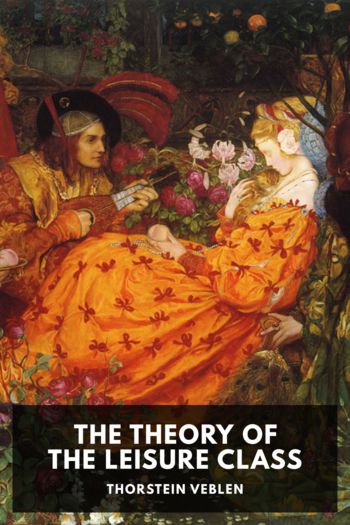The Theory of the Leisure Class - Thorstein Veblen (english books to improve english txt) 📗

- Author: Thorstein Veblen
Book online «The Theory of the Leisure Class - Thorstein Veblen (english books to improve english txt) 📗». Author Thorstein Veblen
If we go a step back of this exemplary barbarian culture, into the lower stages of barbarism, we no longer find the leisure class in fully developed form. But this lower barbarism shows the usages, motives, and circumstances out of which the institution of a leisure class has arisen, and indicates the steps of its early growth. Nomadic hunting tribes in various parts of the world illustrate these more primitive phases of the differentiation. Any one of the North American hunting tribes may be taken as a convenient illustration. These tribes can scarcely be said to have a defined leisure class. There is a differentiation of function, and there is a distinction between classes on the basis of this difference of function, but the exemption of the superior class from work has not gone far enough to make the designation “leisure class” altogether applicable. The tribes belonging on this economic level have carried the economic differentiation to the point at which a marked distinction is made between the occupations of men and women, and this distinction is of an invidious character. In nearly all these tribes the women are, by prescriptive custom, held to those employments out of which the industrial occupations proper develop at the next advance. The men are exempt from these vulgar employments and are reserved for war, hunting, sports, and devout observances. A very nice discrimination is ordinarily shown in this matter.
This division of labour coincides with the distinction between the working and the leisure class as it appears in the higher barbarian culture. As the diversification and specialisation of employments proceed, the line of demarcation so drawn comes to divide the industrial from the nonindustrial employments. The man’s occupation as it stands at the earlier barbarian stage is not the original out of which any appreciable portion of later industry has developed. In the later development it survives only in employments that are not classed as industrial—war, politics, sports, learning, and the priestly office. The only notable exceptions are a portion of the fishery industry and certain slight employments that are doubtfully to be classed as industry; such as the manufacture of arms, toys, and sporting goods. Virtually the whole range of industrial employments is an outgrowth of what is classed as woman’s work in the primitive barbarian community.
The work of the men in the lower barbarian culture is no less indispensable to the life of the group than the work done by the women. It may even be that the men’s work contributes as much to the food supply and the other necessary consumption of the group. Indeed, so obvious is this “productive” character of the men’s work that in the conventional economic writings the hunter’s work is taken as the type of primitive industry. But such is not the barbarian’s sense of the matter. In his own eyes he is not a labourer, and he is not to be classed with the women in this respect; nor is his effort to be classed with the women’s drudgery, as labour or industry, in such a sense as to admit of its being confounded with the latter. There is in all barbarian communities a profound sense of the disparity between man’s and woman’s work. His work may conduce to the maintenance of the group, but it is felt that it does so through an excellence and an efficacy of a kind that cannot without derogation be compared with the uneventful diligence of the women.
At a farther step backward in the cultural scale—among savage groups—the differentiation of employments is still less elaborate and the invidious distinction between classes and employments is less consistent and less rigorous. Unequivocal instances of a primitive savage culture are hard to find. Few of these groups or communities that are classed as “savage” show no traces of regression from a more advanced cultural stage. But there are groups—some of them apparently not the result of retrogression—which show the traits of primitive savagery with some fidelity. Their culture differs from that of





Comments (0)